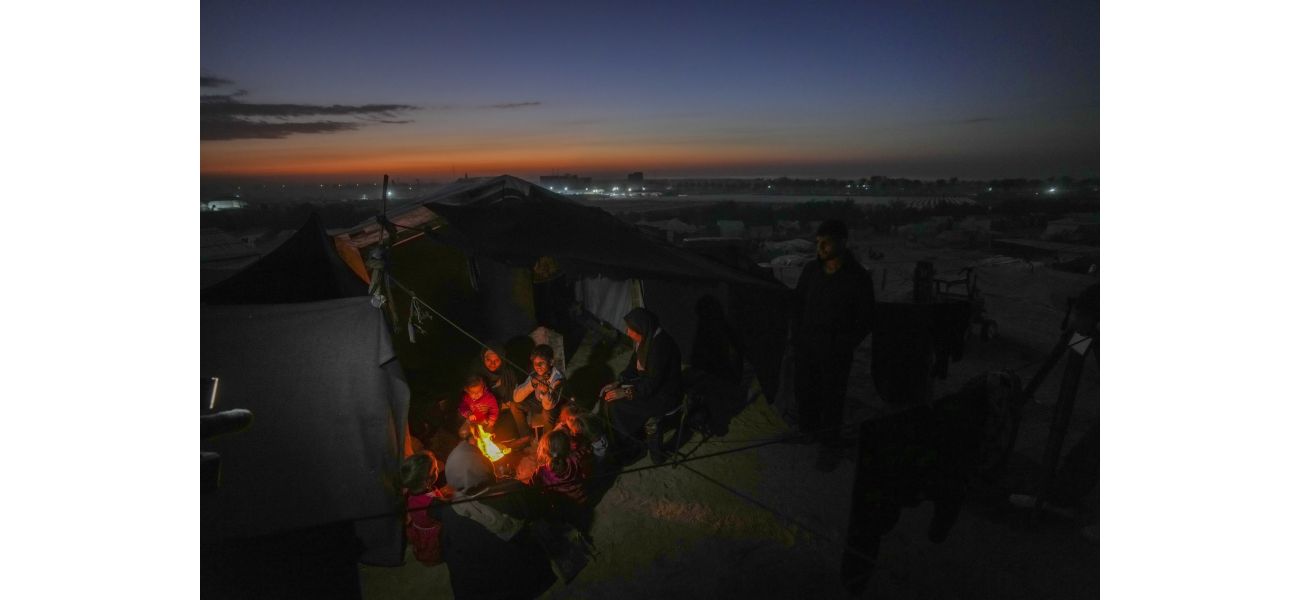Gaza's cold winter leaves Palestinians vulnerable and unprotected.
Omar Shabet, a displaced father staying with his children, feared starting a fire near their tent would make them vulnerable to Israeli airstrikes.
December 22nd 2024.

As the winter season descends upon the Gaza Strip, the harsh reality for the nearly 2 million Palestinians who were displaced by the 14-month war with Israel is becoming more and more apparent. The struggle to protect themselves from the cold, wind, and rain has become a daily battle for those living in makeshift shelters.
According to aid workers and residents, there is a shortage of basic necessities such as blankets and warm clothing. The tents and tarps that families have been living in have become worn and threadbare after months of heavy use. Shadia Aiyada, a mother of eight who was displaced from Rafah to Muwasi, shares her worries about the upcoming rainy and windy days. With only one blanket and a hot water bottle to keep her children warm, she fears that their flimsy tent will not withstand the strong winds.
As temperatures drop into the 40s at night, Aiyada worries that her children will get sick without proper warm clothing. When they fled their home, they only had their summer clothes and have been forced to borrow from relatives and friends to stay warm. The United Nations has expressed concern for those living in precarious shelters that may not survive the harsh winter weather. According to a recent update, at least 945,000 people are in need of winterization supplies, but these have become prohibitively expensive in Gaza.
The UN Agency for Palestinian Refugees, also known as UNRWA, has been preparing for the winter season for months. However, the aid they have been able to get into the territory is not nearly enough to meet the needs of the people. According to agency spokeswoman Louise Wateridge, they have distributed 6,000 tents in northern Gaza but have been unable to reach other areas due to ongoing fighting. Additionally, 22,000 tents, 600,000 blankets, and 33 truckloads of mattresses have been stuck in Jordan and Egypt due to lack of Israeli approval and a safe route to bring them into Gaza.
The International Rescue Committee is also facing challenges in providing aid to Gaza. According to deputy director Dionne Wong, there are numerous approvals required from relevant authorities, making it difficult to bring in much-needed winter clothing for children. The Israeli government has stated that they have been working with international organizations to prepare Gaza for winter, but residents and aid workers say that the winter clothing for sale in local markets is too expensive for most people to afford.
For those living in the makeshift shelters, the cold weather brings many challenges. Reda Abu Zarada, a mother of four who was displaced from northern Gaza, shares that she and her family have to sleep with the children in their arms to keep them warm. With no doors and torn tents, they are often visited by rats at night. Abu Zarada fears that one day she may wake up to find one of her children frozen to death.
Omar Shabet, a father of three who was displaced from Gaza City, also faces challenges during the winter nights. He fears that lighting a fire outside his tent to keep his family warm may make them a target for Israeli airstrikes. As a result, they stay inside their tent after sunset, enduring the cold until they can't take it anymore. Shabet's 7-year-old daughter often cries at night due to the freezing temperatures.
As winter takes its toll on the displaced families in Gaza, they continue to struggle with the harsh reality of living in makeshift shelters. With limited resources and aid, they fear for their safety and the well-being of their children. As negotiations for a ceasefire continue, the hope is that more aid will be able to reach those in need before it's too late.
According to aid workers and residents, there is a shortage of basic necessities such as blankets and warm clothing. The tents and tarps that families have been living in have become worn and threadbare after months of heavy use. Shadia Aiyada, a mother of eight who was displaced from Rafah to Muwasi, shares her worries about the upcoming rainy and windy days. With only one blanket and a hot water bottle to keep her children warm, she fears that their flimsy tent will not withstand the strong winds.
As temperatures drop into the 40s at night, Aiyada worries that her children will get sick without proper warm clothing. When they fled their home, they only had their summer clothes and have been forced to borrow from relatives and friends to stay warm. The United Nations has expressed concern for those living in precarious shelters that may not survive the harsh winter weather. According to a recent update, at least 945,000 people are in need of winterization supplies, but these have become prohibitively expensive in Gaza.
The UN Agency for Palestinian Refugees, also known as UNRWA, has been preparing for the winter season for months. However, the aid they have been able to get into the territory is not nearly enough to meet the needs of the people. According to agency spokeswoman Louise Wateridge, they have distributed 6,000 tents in northern Gaza but have been unable to reach other areas due to ongoing fighting. Additionally, 22,000 tents, 600,000 blankets, and 33 truckloads of mattresses have been stuck in Jordan and Egypt due to lack of Israeli approval and a safe route to bring them into Gaza.
The International Rescue Committee is also facing challenges in providing aid to Gaza. According to deputy director Dionne Wong, there are numerous approvals required from relevant authorities, making it difficult to bring in much-needed winter clothing for children. The Israeli government has stated that they have been working with international organizations to prepare Gaza for winter, but residents and aid workers say that the winter clothing for sale in local markets is too expensive for most people to afford.
For those living in the makeshift shelters, the cold weather brings many challenges. Reda Abu Zarada, a mother of four who was displaced from northern Gaza, shares that she and her family have to sleep with the children in their arms to keep them warm. With no doors and torn tents, they are often visited by rats at night. Abu Zarada fears that one day she may wake up to find one of her children frozen to death.
Omar Shabet, a father of three who was displaced from Gaza City, also faces challenges during the winter nights. He fears that lighting a fire outside his tent to keep his family warm may make them a target for Israeli airstrikes. As a result, they stay inside their tent after sunset, enduring the cold until they can't take it anymore. Shabet's 7-year-old daughter often cries at night due to the freezing temperatures.
As winter takes its toll on the displaced families in Gaza, they continue to struggle with the harsh reality of living in makeshift shelters. With limited resources and aid, they fear for their safety and the well-being of their children. As negotiations for a ceasefire continue, the hope is that more aid will be able to reach those in need before it's too late.
[This article has been trending online recently and has been generated with AI. Your feed is customized.]
[Generative AI is experimental.]
0
0
Submit Comment





